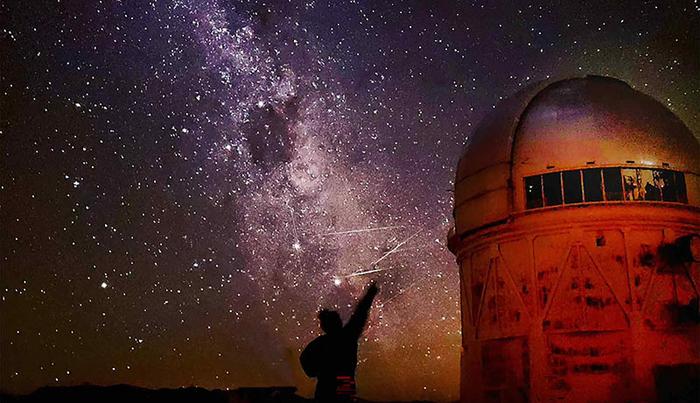Researchers from Rutgers University-New Brunswick have made groundbreaking discoveries about the formation of galaxies during a pivotal period in the universe’s history known as “Cosmic Noon,” which is estimated to have occurred between 2 billion to 3 billion years after the Big Bang. This profound investigation takes a closer look at a special class of galaxies known as Lyman Alpha Emitters (LAEs) that are indicative of the complex processes driving the birth of stars. Their findings not only deepen our understanding of galaxy evolution but also provide new insights into the early dynamics of the universe.
The scientists employed advanced imaging techniques coupled with machine learning methodologies to probe the star formation histories of these ancient galaxies. Their research was published in The Astrophysical Journal Letters, where they detail the critical aspects of their study that reveal the vigorous activity of star formation occurring in these galaxies during their formative years. The research focused on LAEs, which shine with remarkable intensity due to their active star-forming processes, aided by the transformation of ultraviolet light into observable light as the universe expands.
Understanding LAEs is vital as they are among the earliest galaxies formed, dating back over 12 billion years. These ancient entities act as cosmic beacons, illuminating the conditions prevalent in the universe during its infancy and offering astronomers a clearer view of cosmic evolution. The study was spearheaded by Rutgers astrophysicist Eric Gawiser, with Nicole Firestone serving as the first author, shedding light on the historical context of our own Milky Way galaxy.
The initial motivation behind investigating these ancient galaxies was to reconstruct the early state of the Milky Way at the time it began to form stars. Previous findings had suggested that LAEs could be the prototypes of present-day galaxies, indicating that understanding their star formation could provide answers to questions concerning our galaxy’s genesis. By illuminating the timeline of star formation events in these early celestial bodies, the research team has effectively unlocked a segment of the Milky Way’s “origin story.”
A pivotal concern addressed in this research was whether LAEs were merely resuming star formation after a dormant period or if they were indeed witnessing their first significant star formation burst. This aspect is crucial because establishing whether galaxies are at the brink of their developmental phase yields insight into the broader mechanics of galaxy evolution over time. The results of this research demonstrate that a substantial majority of LAEs are engaged in their inaugural major starburst, indicated by the presence of predominantly young stars.
Through data obtained from the ODIN project, the researchers utilized the Dark Energy Camera housed in the Cerro Tololo Inter-American Observatory in Chile. This facility is renowned for capturing highly specialized images of the cosmos across vast spans of sky, enhancing the potential for identifying LAEs, which exhibit a distinct brightness in the captured images compared to conventional observable light. The ODIN project’s name, standing for “One-hundred-deg2 DECam Imaging in Narrowbands,” reflects its focused aim alongside the advanced technological capability of the observational equipment.
The analysis process of recorded light emissions from LAEs involved machine-learning techniques to infer vital physical properties, including how rapidly the stars formed over time. This approach allowed the researchers to reconstruct what they describe as a “life story” for each LAE in their examined sample, presenting an intricate view of their evolutionary paths through cosmic history. The methodological advancements developed at Rutgers provided a fresh means of understanding these galaxies’ developmental narratives, bringing significant contributions to the field of astrophysics.
An astonishing 95% of the LAEs examined during this extensive study were found to be at their peak phases of star formation, a revelation that confirms these galaxies are, indeed, in a critical early stage of their evolution. Such findings are transformative, enabling scientists to piece together more coherent timelines and processes connected to galaxy formation, thereby illuminating aspects of our own Milky Way’s inception and broader cosmic context.
The implications of this research extend beyond merely understanding LAEs; they provide a clearer window into what the universe looked like during its nascent stages. By clarifying the environments conducive to significant starbursts in galaxies, the researchers underscore the importance of identifying and understanding the conditions under which these remarkable star-forming events unfold.
In summary, the discoveries made by the Rutgers-led team concerning Cosmic Noon and the starburst activities of LAEs may redefine our understanding of cosmic evolution and the formative processes of galaxy development. As researchers continue to explore these distant galaxies, each finding builds upon the existing knowledge, ultimately helping to construct a more complete historical narrative of our universe’s past.
This groundbreaking research also plays a vital role in the ongoing discourse among astronomers and astrophysicists regarding how galaxies evolve and shape the fabric of the cosmos. With each new study, the mysteries surrounding our universe’s early days become a bit clearer, guiding scientists closer to understanding the intricate web of formation and evolution that leads to the galaxies we observe today.
The ongoing exploration into the early stages of galaxy formations and star bursts heralds a new era of astrophysical research, providing critical insights that have the potential to reshape our comprehension of the universe. As the team continues to analyze and publish their findings, they hope to inspire further research and discovery within the astronomical community.
Subject of Research: Lyman Alpha Emitters and Star Formation Histories
Article Title: ODIN: Star Formation Histories Reveal Formative Starbursts Experienced by Lyα-emitting Galaxies at Cosmic Noon
News Publication Date: 4-Jun-2025
Web References: https://iopscience.iop.org/article/10.3847/2041-8213/adbf8c
References: N/A
Image Credits: Nicole Firestone/Rutgers University
Keywords
Cosmic Noon, Lyman Alpha Emitters, Rutgers University, Star Formation, Galaxies, The Astrophysical Journal Letters.




